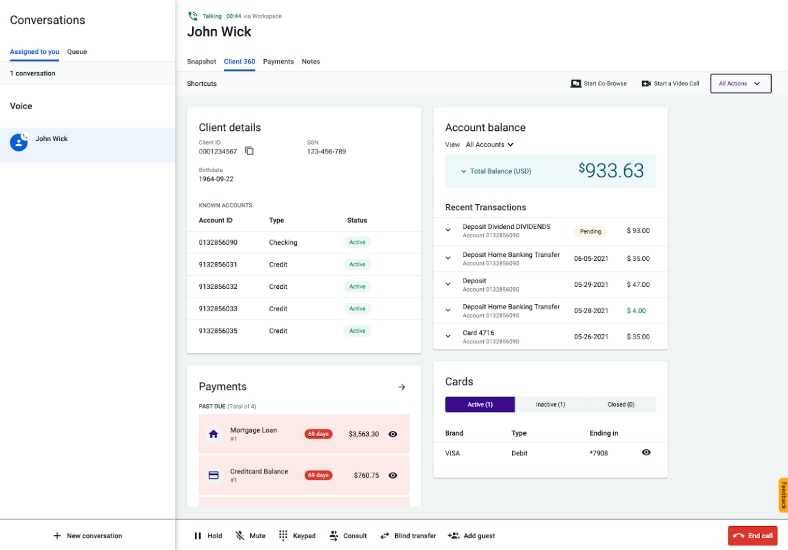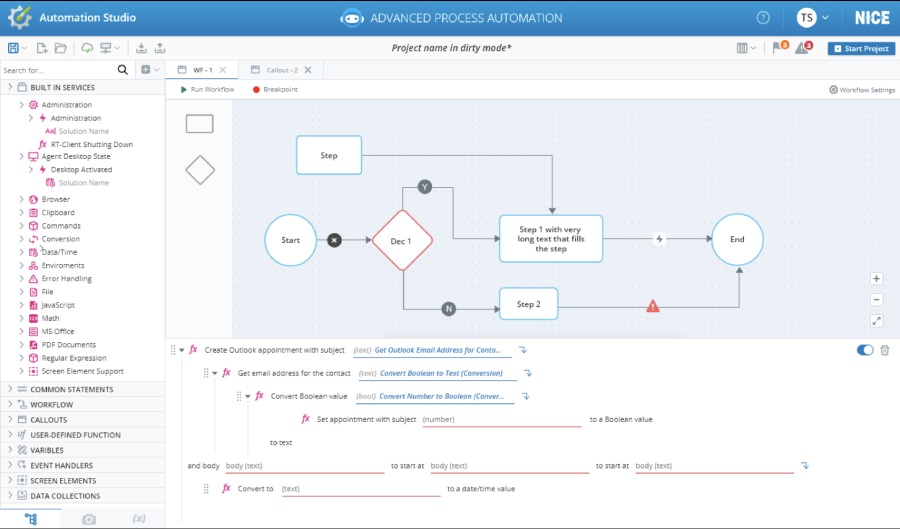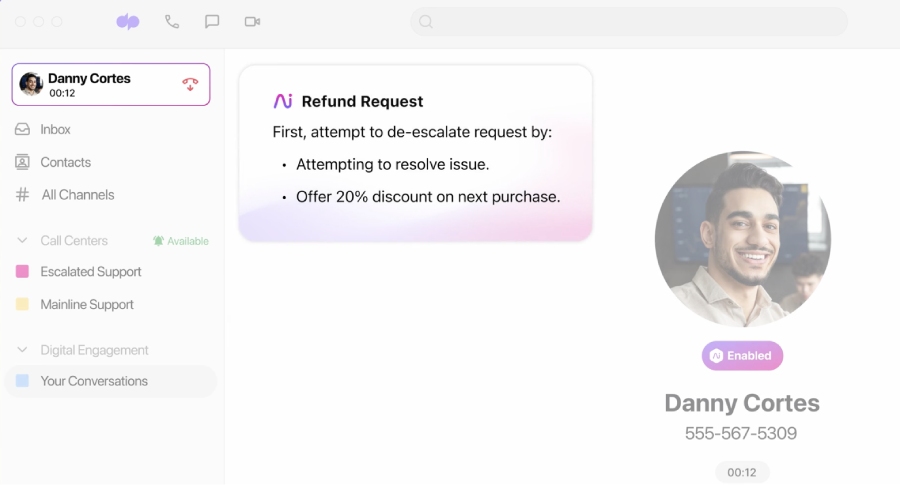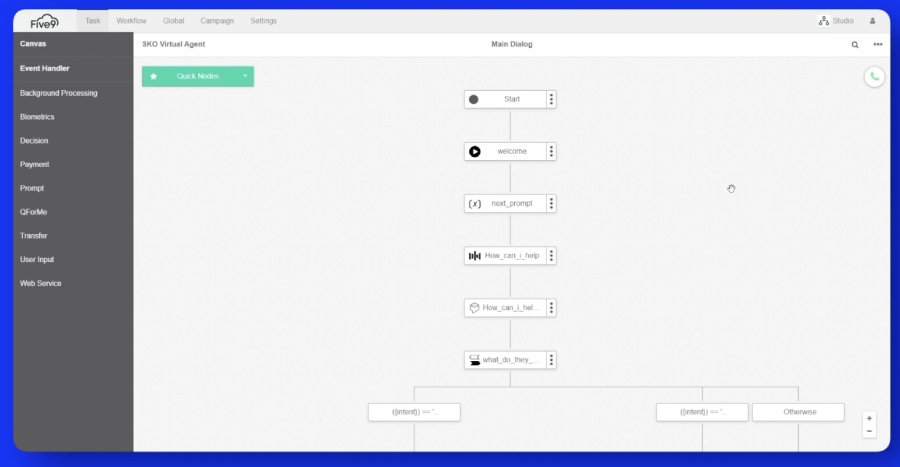The latest contact center as a service (CCaaS) statistics show that the market is set to further expand at a compound annual growth rate (CAGR) of 19.1% from 2023 to 2030. As more customers adopt digital solutions to seek services from different industries, businesses accommodate the demand by embracing an omnichannel approach to customer service.
The rise of advanced technologies like artificial intelligence (AI) will spur market growth further in the next few years, as these contribute to enhanced customer experience and increased agent productivity. In this article, we’ll explore more CCaaS trends and statistics and help you identify opportunities for business process improvement.
If you need a refresher on the definition and capabilities of contact center as a service (CCaaS) solutions, visit our comprehensive guide on what CCaaS is. The article outlines top providers, which should help you decide which platform to choose.
State of the Contact Center Market
The CCaaS market has a more expanded client base today, spanning different industries, given its benefits of improved customer service. This section explores the kinds of businesses driving CCaaS growth, the most popular solutions, and the overall state of the market.
1. The banking, financial services & insurance (BFSI) industry is the top-paying CCaaS user
Source: AgileIntel Research
The industry contributed the biggest revenue share in the CCaaS market in 2021, representing over 26%. The increased adoption of digitalization in the sector and the strong demand for digital banking services among clients compel several companies to use CCaaS platforms.
Some CCaaS and voice-over-internet protocol (VoIP) providers offer industry-specific solutions for the BFSI sector. For instance, the workspace dashboards provide a summary of all the clients’ financial transactions. This offers meaningful context to the agent-customer conversation.

See all your customers’ financial information on Talkdesk. (Source: Talkdesk)
Popular contact center solution Talkdesk features Financial Services Experience Cloud, a platform equipped with tools specifically designed to help financial services providers streamline customer communications. Its Payments and Collections reminders allow businesses to automatically send text notifications to customers at a predefined date.
2. The consumer goods & retail industries are expected to have significant growth between 2022 & 2029
Source: AgileIntel Research
As more people turn to online shopping, more ecommerce firms are expected to adopt CCaaS solutions to provide cross-channel communications and maximize automated services. Some contact center systems, like Talkdesk, seamlessly work with Shopify, allowing teams to access the most recent and relevant customer, product, and order information from the ecommerce platform. A customer’s contact details and order history are automatically displayed on Talkdesk whenever an agent interacts with a consumer.
3. Automatic call distribution (ACD) is the most in-demand CCaaS solution
Source: AgileIntel Research
The ACD solution segment accounted for the largest revenue share in the CCaaS market, representing 22% in 2021. This capability enables contact center systems and VoIP phone systems to route inbound calls to the right agents.
The next most in-demand solution is interactive voice response (IVR), which employs speech recognition technology to gather information about callers and route them to the most qualified customer service representatives. Other popular CCaaS solutions are computer technology integration (CTI), call recording, dialer, reporting and analytics, and workforce optimization.
4. More businesses in North America use CCaaS solutions than in other regions
Source: AgileIntel Research
North America represented 36% of CCaaS market revenue share in 2021. At the height of the pandemic, the region saw an increase in call volumes in different industries, including BFSI, information technology, and telecommunications, which made companies turn to CCaaS solutions.
Asia Pacific is set to see the highest growth rate in the medium term, especially as the ecommerce firms strengthen their operations in the area.
5. NICE CXone leads the list of top CCaaS providers by revenue share
Source: Metrigy
NICE CXone, a platform that supports digital, voice, and omnichannel customer engagement, held the biggest revenue share in the CCaaS market in 2022. The next most popular providers, based on revenue share, were Genesys and Five9. Other leading vendors were AWS, Talkdesk, 8×8, Vonage, Cisco, Twilio, and Dialpad.

Free agents from repetitive tasks with NICE CXone’s workflow automations. (Source: NICE CXone)
NICE CXone is known for its robust automation tool, which eliminates mundane, repetitive work from agents’ task lists and allows team members to focus on high-value initiatives. Its automation studio features an intuitive interface, enabling users to develop and configure automations easily even without technical know-how.
Its open framework and software development kit offer opportunities for enhancing the contact center platform with new features specific to one’s business needs.
Key Customer Service Success Elements & Challenges
Contact center platforms feature reporting and analytics tools to measure agent performance and evaluate customer sentiment and experience. In this section, we’ll tackle the most important CCaaS statistics referring to customer service success and challenges.
6. One-third of professionals think self-service offers the best value for money, among other support efforts
Source: Call Centre Helper
In a 2021 survey of more than 200 contact center professionals, about 36% believed that promoting self-service offers the best return on investment (ROI) among customer service initiatives. When customers find answers and solutions for themselves without talking to a live support agent, there’s less need for more human representatives. Moreover, the existing workforce is able to focus on more serious concerns. An efficient team lowers operational costs in the long run.
About 62% of the survey participants shared that they see self-service as an important growth channel for customer experience. Moreover, self-service is among the top five priorities of the respondents in 2022.
7. Effective customer experience design comes from customer feedback
Source: Call Centre Helper
About 72% of surveyed respondents say that customer feedback is the most important consideration when mapping out customer experience and determining the audience’s pain points. The next most critical factor is technology capabilities, followed by employee feedback.
8. Customers want knowledgeable advisers the most, among other contact center offerings
Source: Call Centre Helper
About 32% of professionals believe that customers value support agents who offer sound, meaningful advice on their concerns. Interestingly, the next most popular priority is first-call resolution—the ability of a service representative to address issues the first time a customer contacts the business.
Efficiency, effective follow-up, and timely responses are likewise priorities for customers, according to the contact center professionals surveyed.

Dialpad offers response suggestions for customer concerns. (Source: Dialpad)
Dialpad Contact Center features built-in coaching capabilities powered by artificial intelligence (AI). As agents accommodate customer concerns, the system analyzes the conversation and offers recommendations for representatives on how to respond. This lets team members offer professional advice and speed up addressing inquiries and requests.
9. Analytics & reporting are the most valuable contact center features
Source: Genesys
Fifty-seven percent of businesses considered real-time and historical analytics and reporting as extremely valuable in addressing customer needs and providing better services. The tool offers meaningful insights about customer sentiment and behavior as well as team performance patterns, which in turn inform communication strategies and coaching programs.
Meanwhile, about 54% claimed that customer data platform was most useful to them, while 48% pointed to workforce engagement management. Forty-seven percent voted for the unified agent desktop application.
10. 85% of professionals think that customer satisfaction is a ‘very important’ contact center metric
Source: Call Centre Helper, SQM Group
Customer satisfaction is the top-voted “very important” metric. The next most critical are service level (73%), first contact resolution (69%), quality scores (68%), and customer complaint volumes (65%). Meanwhile, 64% claimed that the abandonment rate is very important.
According to SQM Group, the following figures are the 2023 industry benchmarks for some of the mentioned metrics:
Contact Center Metric | Industry Benchmark |
|---|---|
Customer Satisfaction | 77% |
Service Level | 80/20 (80% of inbound calls are answered) |
First Contact Resolution | 68% |
Abandon Rate | 6% |
11. The customer experience (CX) index dropped in 2023
Source: Forrester
This is the second year in a row that the CX Index has declined, with businesses failing to deliver customer experiences that create and sustain loyalty. The CX index has three criteria points:
- Effectiveness, which measures how effective the brand is at accommodating customer needs
- Ease, which evaluates how easy it is to work with the brand
- Emotion, which assesses how the customer felt about their interaction with the brand
The decline in CX index is attributed to a “talent-constrained recession” amid increasing customer expectations. On the flip side, the luxury auto manufacturing and retail industries improved their industry-average CX score in 2023.
12. Almost half of businesses struggle to keep pace with rising customer expectations
Source: Genesys
This is the top challenge businesses encounter when improving customer experience, with 43% of surveyed respondents claiming that they have a hard time accommodating market demands. About 40% said that the challenge was staff training on new tools and protocols and improvement on self-service tech. Meanwhile, 39% had difficulties managing quality and productivity amid the remote and hybrid work setup.
Adoption of Multi & Omnichannel Communication
With the continuing growth of smartphone and social media use, more customers have turned to digital communication channels to reach out to businesses. In turn, companies have been stepping up their multi and omnichannel strategies, accommodating stakeholders beyond phone calls and extending services on live chat, video calls, and social networking sites.
The CCaaS statistics below show how organizations approach communications on various platforms.
13. Many companies used multiple channels to communicate with customers amid the pandemic
Source: ExpertMarket
About 79% of organizations increased the number of digital communication channels used in their business to engage customers. Video calls and emails were the most popular channels, with 74% of companies adopting them. Telephones followed, with 50%.
14. Businesses want unified communications in their contact center platforms
Source: Metrigy
In a Metrigy survey, only about 39% of companies said they don’t plan on replacing their primary CCaaS provider. The rest of the participants were looking for a new provider, considering having a new one, or unsure.
These companies are compelled to make the switch, as they prefer a contact center solution integrated with unified communications (UC) features. UC integrates voice calling, video conferencing, and instant messaging in a single platform.

Manage team and customer communications on RingCentral. (Source: RingCentral)
RingCentral Contact Center offers native UC features, allowing teams to collaborate via chat and video meetings. It’s easy for employees to find the information they need since all types of business communications are centralized in one platform. Moreover, businesses reduce costs, as they can do away with maintaining multiple communication tools. If you’re interested in learning more about RingCentral’s capabilities, visit our RingCentral Contact Center review.
Visit RingCentral Contact Center
15. 59% of customers who use live chat want to talk to human representatives
Source: HubSpot
More than half of survey participants prefer communicating with a human support agent over a virtual assistant. However, 30% said that while they want live representatives, they will engage with a chatbot if they need to. Approximately 66% of respondents expect a response from the support team within five minutes. Interestingly, live chat is the third most popular communication channel for a customer’s initial contact. The most preferred is phone, followed by email.
16. About half of customers engage with businesses on social media to resolve issues
Source: Khoros
Approximately 53% of Twitter users reached out to brands’ pages for customer support, and 46% on Facebook and Instagram. The most common reason for communication is asking questions about products and services. Unlike in live chat, social media users don’t expect an immediate reply from brands. Half of the surveyed respondents are fine with replies within three hours.

Manage social media queries on Genesys. (Source: Genesys)
Popular contact center platform Genesys allows businesses to see and respond to customer concerns from different social media platforms in one place. The channels include Facebook, Twitter, Instagram, and messenger apps WhatsApp and LINE. The queries can be routed to agents based on skills, keywords, languages, or preferred agents.
17. 54% of customers would try live video for assistance on issues
Source: Zoom
About one-fourth of surveyed respondents said that they previously used live video for customer support. One in three would consider using this communication channel in the future. People have various motivations for trying video for customer service: 54% for assistance with problems, 50% for a refund request, 49% for order cancellation, and 48% for inquiries on a product or service.
The Future of Contact Center Systems
Contact center platforms are expected to see more innovations, with AI leading the development. At the same time, more companies will adopt cloud-based technologies to support the new normal of remote and hybrid work. Be on the lookout for these important CCaaS trends unfolding in the next three to 10 years.
18. The majority of businesses will adopt cloud-based contact center solutions in the near term
Source: Deloitte
Approximately 77% of surveyed business leaders said they plan to migrate their contact center IVR to the cloud by 2025. Meanwhile, 73% will adopt cloud-based interaction recording solutions. Businesses will conduct cloud migration on other core contact center technologies: customer relationship management (72%), knowledge management (70%), ACD (68%), workforce management (63%), and analytics (60%).
19. Bots will significantly cut down labor costs by as much as $80B in 2026
Source: Gartner
On top of this, conversational AI is expected to accommodate one in every 10 conversations by 2026. While reducing the need for human labor, they help deliver personalized services to customers, as these bots are able to collect data on customer preferences and needs. For businesses, this functionality offers opportunities to understand the audience better and make data-driven decisions.

Use Five9’s intelligent IVA to facilitate self-service to customers. (Source: Five9)
Five9’s intelligent IVA is powered by natural language processing, sentiment analysis, speech recognition, and text-to-speech, which facilitate call resolution without human intervention. This tool is especially useful when you have call volume spikes, as IVAs are able to accommodate customer concerns and leave complex requests to human agents.
20. Spending on contact center AI will reach $23B in 2024
Source: Gartner
Economic uncertainty may hinder increased investments in information technology projects. However, businesses are more likely to make exceptions on customer engagement and revenue-generating initiatives, which include choosing CCaaS solutions equipped with AI tools.
Gartner forecasts spending growth on contact center AI, hitting $18.6 billion in 2023, an increase of 16.2% from 2022. It will rise to $23B in 2024, inflating by 24% from the previous year.
Frequently Asked Questions (FAQs)
A CCaaS system is a cloud-based software solution that allows users to handle customer communications on different channels, including phone, email, social media, and live chat.
CCaaS primarily functions to streamline customer communications. Most platforms offer the following capabilities:
- Omnichannel routing: Distributes queries from different communication channels to the most qualified agents
- IVR: Plays a prerecorded announcement of menu options for various customer needs and sends callers to the appropriate agents or departments
- Dialer: Automatically dials customers’ phone numbers to support efficient customer outreach
- Workforce management: Optimizes agent performance, monitors employee scheduling, and ensures that enough team members are available to accommodate contact center volume
- Reporting and analytics: Provides meaningful insights about team performance and customer behaviors
In 2022, the global contact center as a service (CCaaS) market size was valued at $4.43 billion, as reported by Grand View Research.
Bottom Line
The contact center as a service stats above prove that these platforms will continue to play a huge role in business communications in the coming years, especially as they get equipped with more advanced technologies that make customer engagement more efficient. When choosing a CCaaS solution, consider its ease of use and set of features, particularly omnichannel routing, workforce management, and real-time and historical reporting and analytics.
If you want to focus on improving phone support, check our list of the best call center phone systems and see which ones fit your business requirements.